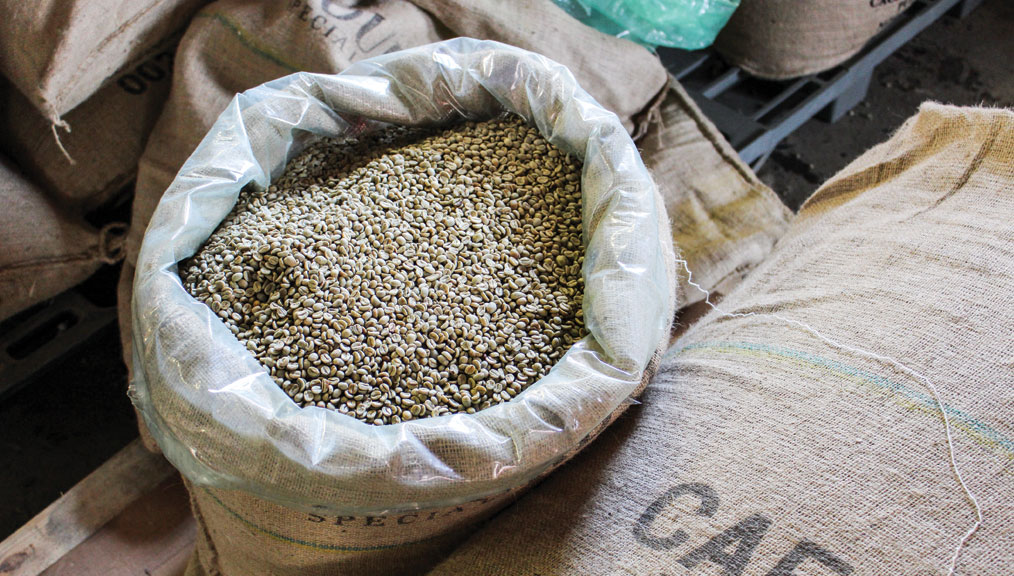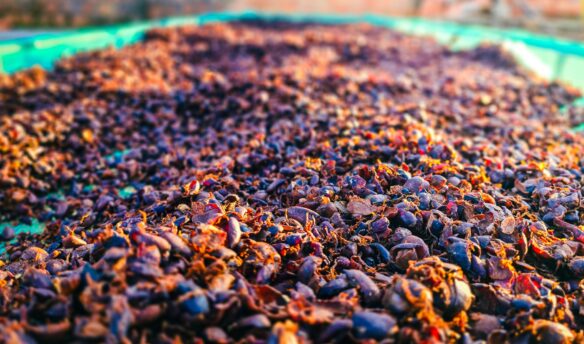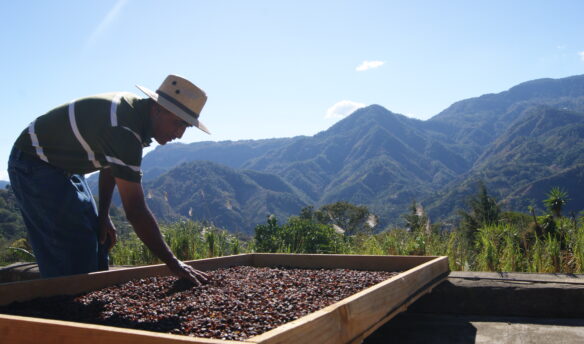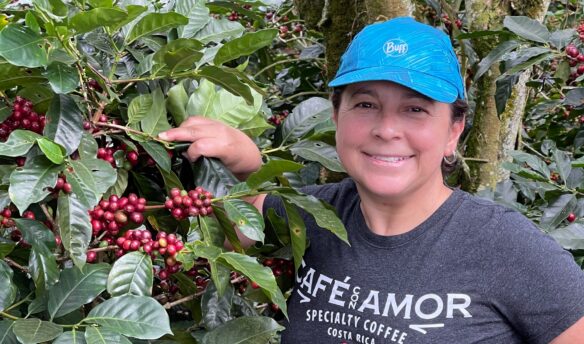[S]ince 2008 coffee futures have been traded digitally; today, anyone can check market prices though smartphone apps. Coffee producers are active members of the entire supply chain and can chat with roasters over Skype or share harvest photos on their farm’s Facebook page. Information shared via online media is helpful to roasters buying green coffee, but three new platforms take advantage of digital connectivity when sampling, sourcing, and buying green coffee.
In the past, green coffee buyers sought beans based on specs like screen size, defect count, crop year, lot size, and country or broad region of origin. The first online sourcing tools were simply digital offerings lists published by traditional sellers (importers and brokers) and updated in real time as coffees arrived or were sold. Now, online sourcing platforms are not just digital versions of analog tools, they are ways to identify lots still at origin, compare products from diverse suppliers, and even place orders for delivery.
Beanstock.ag aggregates spot inventories of green coffee available in US warehouses—stocks equally available to all buyers, like products on a store shelf and available by the bag or by the container. Through the San Francisco–based web platform, importers can list any spot offerings they want displayed. “Beanstock provides a comprehensive view of coffee offerings as well as an intuitive search interface,” says co-founder and CEO Nick Spilger. “Roasters can search as widely or narrowly as they wish. If I want a Central American coffee with notes of chocolate and cherry, certified organic, located in Oakland, California, with at least twenty bags available, I can pinpoint the exact coffees that meet my needs. Or if I just want to see what’s currently available in Oakland, I can browse that as well.”
A Virtual Warehouse
Beanstock’s scope focuses exclusively on streamlining the sample-request process for roasters. The site updates daily by pulling information from published data on importers’ websites. Through Beanstock’s data aggregation, roasters can request samples from multiple companies, simultaneously opening communication with each of them and making follow-up as easy as hitting “Reply.”

Cropster Hub, based jointly in Innsbruck, Austria, and Sacramento, California, takes its interface cues from successful online marketplaces like Amazon, Ebay, or Etsy by providing roasters the option to “Add to Cart.” Depending on the seller, users can order samples of listed coffees or complete the whole transaction online and purchase the volumes of green coffee they will roast for customers—packaged in units from thirty-pound vacuum-packed boxes to 132-pound bags.
Paul Bartholomew, head of global marketing and communications with Cropster Hub, explains that the platform presents specialty green coffees sourced from around the world and from various players across the coffee supply chain. “Green coffee buyers can search for coffees by origin or by extended parameters of key importance to the specialty market, like flavor profiles, tasting notes, score ranges, varietals, certifications, processing, and even warehouse,” Bartholomew says.
Learning from the Experts
Cropster Hub offers coffees beyond those available in the warehouse, including in-transit green coffee and crops still being prepared at origin. In addition to listings from importers, the Hub also includes offerings from exporters, mills, and co-ops. The platform reaches further upstream in the supply chain, giving a variety of stakeholders new ways to access the market.
“Hub itself is the result of many players describing a specialty green buying model they would like to engage in,” Bartholomew says. Cropster software is already widely used for tracking roasting profiles, and the Hub leverages this network to involve more actors in the process of commercializing coffee. “Hub is completely accessible via mobile,” Bartholomew says. “This is a critical feature for people whose jobs require that they are on the road a lot. Hub on a tablet or phone is completely responsive.”

Bartholomew explains that Hub’s focus on mobile becomes even more relevant in the context of auctions, one of the ways the specialty industry has promoted high-quality coffees and celebrated producers. “Hub customers have held auctions at origin where everyone used the Hub auction platform,” he says. “Buyers across the world and within the room were able to bid against each other in real time. People at origin simply used their phones to participate. This created a completely level playing field in the auction.”
While Cropster Hub facilitates coffee transactions, it does not explicitly manage them. Coffee orders placed in a buyer’s cart are then forwarded to the seller, who completes the invoicing, shipping, and delivery portions of the transaction. The Hub functions like a virtual broker, facilitating trade without handling the physical product.
Tapping a Global Network
Algrano, developed in Zug, Switzerland, handles physical coffee in addition to facilitating the ordering process, making sourcing coffee directly from growers a completely web-based experience.
Algrano offers roasters a global network of coffee professionals, micro-lot separated coffees, price transparency, space booking, and search tools. The most unique of these services is the ability to book space in a shipping container. While finding the right coffee is key and communicating with producers promotes transparency, micro-lots often get stuck at origin or trapped in the wrong container because there is no centralized way for roasters to communicate with each other—or with the exporters and importer providing logistics services—to consolidate lots bound for a common port.

In this way, Algrano uses the internet not as an alternative way to organize information about what is already happening, but to act as a coordinating bridge between growers and roasters, enabling partnerships that otherwise would not have been possible. When a coffee is sold on the platform, Algrano assumes the organizational steps to deliver the coffee to roasters across Europe.
Micro-lots often get stuck at origin or trapped in the wrong container because there is no centralized way for roasters to communicate with each other.
Working with different sourcing platforms demands different timelines. Because Algrano is not a warehouse inventory representing stocks in the ports of consumer countries, coffees sourced through Algrano incur a waiting period as requested coffees are prepared, loaded, and shipped. Contrarily, warehouse spot inventories have completed this process, eliminating the waiting period before vendors offer coffees for sale to roasters.
Because Algrano starts at origin and Cropster Hub lists some coffees in origin positions, these two platforms offer more producer involvement. Beanstock and Cropster Hub have offerings from more countries, while Algrano is more engaged in the countries where it sources.
Raphael Struder co-founded Algrano and manages finance and sales. “Algrano established supply chains in Brazil, Nicaragua, Costa Rica, Guatemala, and soon Colombia,” he says. “Any growers from these countries are eligible to present their coffees on Algrano. There is no certification necessary. However, growers certified or verified by one of the common standards [UTZ, Rainforest Alliance, Organic, Bird Friendly, 4C, CAFE Practices, AAA Nespresso, etc.] can mention it on their profile and in the case roasters are interested to use the label, they can ask for the certificate.”
Enhancing Relationships
All online platforms aim to simplify dialogue and communications in an industry that extends worldwide. Beanstock’s Spilger sees the digital platforms as a way to enhance stakeholder interaction throughout the supply chain. “Rather than digitize an industry that is rooted in human interactions, we provide information and analytics that enable buyers, importers, exporters, and producers alike to connect with each other and make more informed business decisions,” he says.
Alden Hozouri of Crossings Coffee Roasters in San Diego, California, has used both Beanstock and Cropster Hub to source coffee; through these platforms he now also communicates directly with importers. “As a new roaster, I thoroughly appreciate the integration of Cropster’s tools to keep all my relevant work in one place from Hub to roast.” Hozouri says. “Furthermore, it connects more corners of the globe together, opening doors to exciting beans we might otherwise miss out on.”
Digital platforms are an efficient way to navigate the sea of options available to new people and businesses starting in specialty coffee. As one of the first Beanstock users, Hozouri knows that each digital sourcing platform has different coffees to offer, proving just how large the pool of options is. “It’s a learning curve to figure out which tools fit better with our work flows,” he says.
Digital sourcing services also provide new data to help direct the future of coffee. As consumer tastes change and production technologies evolve, conjectures about these preferences fly around the coffee world. But rather than plant out a mountainside and build parabolic dryers based on the rumor that “everybody loves honey Geisha,” web-based platforms allow for quantifiable data and analytics, enabling all members of the industry to see what roasters are most often looking for while discovering how these desires align with the coffees producers are most inclined to offer.
—Rachel Northrop is a sales rep with Ally Coffee’s specialty importing division and the author of When Coffee Speaks: Stories from and of Latin American Coffeepeople.
















